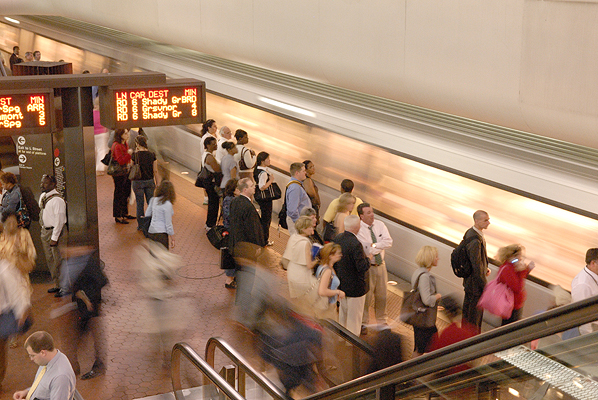
Riders watch a train approach at the Farragut North Metrorail station. Credit: WMATA Photograph by Larry Levine
The new M Shop is “a great opportunity for people to get something unique from Metro, whether you are a visitor looking for a souvenir or an everyday rider,” said Metro General Manager/CEO Paul J. Wiedefeld in a statement introducing the besieged transit system’s venture into merchandising. “At the same time, M Shop represents another potential source of revenue to help support Metrorail and Metrobus.”
The store, which made its debut Wednesday, sells clothing, mugs and other paraphernalia that contains maps, trains and logos. Some items are available at the shop while others are exclusively available online. One popular item are the Foggy Bottom yoga pants, which sell for $45.
But many Metro riders took to Twitter to express their frustration with the M Shop, WMATA and the recent Back2Good campaign, citing what they said was WMATA’s prioritization of publicity and the M Shop over long-overdue safety repairs.
“Maybe we could interest you in a stress toy? #wmata,” tweeted Hakuna WMATA, an account that routinely blasts Metro for its troubles.
“I think it’s kind of a waste,” said Tyler Mertins, the digital media manager at the National Press Foundation who prefers biking over using the Metro. “I feel like they need to focus on moving people.”
Jawauna Greene, Metro’s senior director of marketing, proposed the creation of the M Shop.
“The Metro system is a recognizable landmark for visitors from around the world,” she explained days before the opening. “M Shop lets them take the iconic Metro brand home with them.”
In the face of widespread mocking of the project, Greene responded on Twitter: “Thanks haters!!! We are making money.”
The proceeds from the M Shop will be going to the operating budget, Metro spokeswoman Sherri Ly said.
“Riders consistently tell us that they want to see us maximize every possible source of revenue before asking them to pay more,” Ly said. “They support bringing in more money through advertising, maximizing real estate revenue, and yes, generating revenue from the iconic Metro brand. … Every dollar counts.”
These shops are “common practice in the transit industry – New York MTA has a very well-established transit museum and shop, plus an online presence,” Ly said. Boston, Chicago, Los Angeles, Philadelphia, and London all have similar stores, she added. Not all are brick-and-mortar locations like WMATA’s – some have shops exclusively online.
In some cities, the proceeds from merchandise stores do not go to rail maintenance and fare reduction.
But in Boston, a royalty structure that funnels money to a general fund is applied to the products sold in the shop, and can range from 10 to 50 percent depending on the product said Steven Beaucher, a product developer for MBTA.
Metro’s M Shop grand opening featured DJs, balloons, free giveaways, and a photo booth. Very few people came initially, and a lot of the reaction was on the Web.
The opening of the M Shop comes as Metro’s Back2Good initiative promises riders fewer delays, safer rail cars and higher accountability. One of the system’s new pledges promises reimbursements to riders with SmarTrip cards whose rush-hour trips are delayed by 15 minutes or more.
The campaign has received mixed reviews, with some celebrating the changes, while others believe WMATA is not doing enough. In WMATA’s Back2Good Promise update for February, 90% of Metrorail trips were deemed on time during rush hour and 36 stations had free in-station WiFi.
Despite the train improvements and fewer delays, WMATA’s higher fares and shorter hours are frustrating to riders across the transit system.
Just last week, delays and eventually a suspension to the Orange and Blue lines sparked a brief trend on Twitter.
The M Shop is a currently a “‘proof of concept’ to demonstrate how retail shops might be executed in Metro stations to generate additional revenue” in the future, Metro said.
“If they can make revenue from it enough to help improve the system and put the money towards what they need to put it towards, then it could be worth it,” Mertins said.
